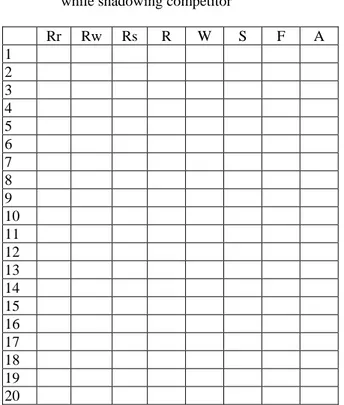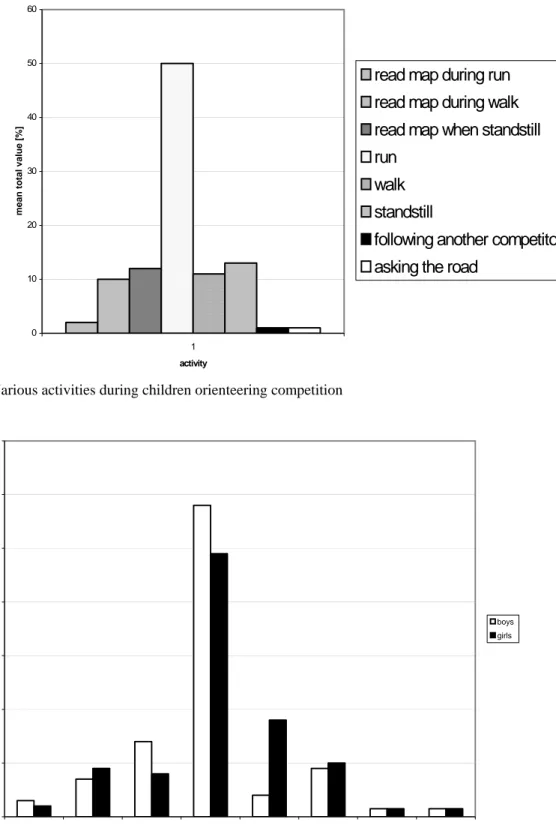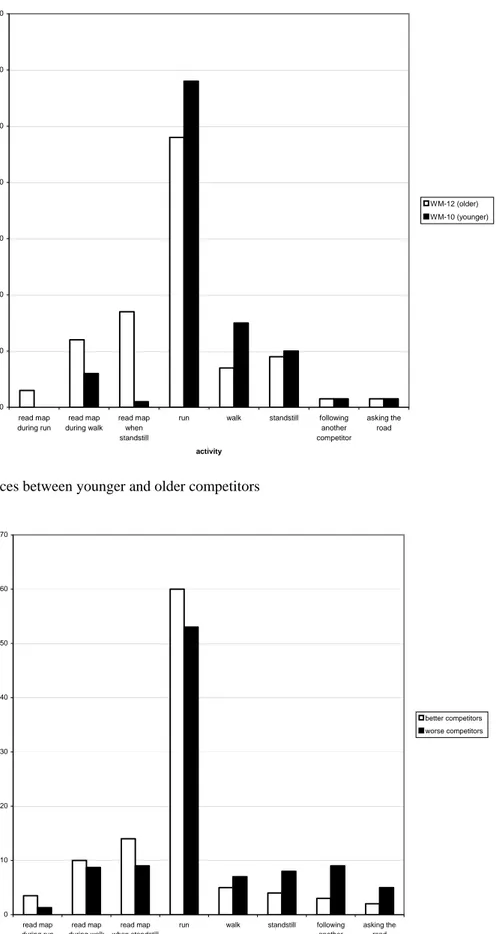STUDIES IN PHYSICAL CULTURE AND TOURISM Vol. 14, Supplement 2007
PIOTR CYCH
Department of Sport Science, University School of Physical Education in Wrocław, Poland
STRUCTURE OF ACTIVITIES IN CHILDREN’S ORIENTEERING
Key words: orienteering, action structure, child.
ABSTRACT
The aim of this research was to determine the time structure of individual activities of young orienteers. The carried out observations were to determine the character of activities performed by beginners (mainly in terms of time ratio set aside for these activities). The practical aim was to establish training guidelines to modify training content and improve orienteering activities. The study was carried out on a group of the youngest orienteers. The shadowing technique was used during research as the main method of data collection. The data was then recorded in observation datasheets prepared by the author. The research results showed that there were differences in time set aside for map reading in different age groups and that there is a relation between orienteering competition results and time allotted for map reading. The results also revealed the fact that girls allowed more time for walking than boys.
INTRODUCTION
Orienteering is a sport in which physical effort is of endurance character. Every orienteer possesses a specialist, detailed map with information on the territory in which the route is set [7]. A competitor picks up the map at the start, tries to reach check points in designated order and reach the finish in the shortest possible time. Orienteering maps used in forested areas are drawn to 1:10 000 or 1:15 000 scale, in parks or urban terrain − 1:4000 or 1:5000 scale. It means that 1 cm on the map corresponds to 40 or 50 m in reality. Map reading and understanding requires a number of skills from orienteers, such as projection and scale understanding [9]. When combining map reading with motor activities such as walking or running, one must learn how to read maps on the run. It is a complex co-ordination activity for young people. When the map during walking without any obstacles such skills can be learnt after a few
hours of orienteering training. But, when a competitor has to read a map while running on a bumpy route with many natural obstacles of different types, he or she may develop map-reading skills for many years [3]. This activity becomes more complex in a more difficult environment. The variability of land forms, flora or the number of natural and artificial objects’ number per unit surface make up terrain complexity and its image on the map [4].
Map reading problems experienced by the youngest participants have been observed during coaching. Many young people seem to experience map-reading problems while moving in the field. Unfortunately, most such observations have been made sporadically and no efforts have been made to determine the structure of activities executed during an orienteering race by the group of youngest participants [12]. This problem is of great significance for the effectiveness of further training and map reading improvement, and it can significantly
Correspondence should be addressed to: Piotr Cych, Katedra Teorii i Metodyki Dyscyplin Sportowych, Zespół
Teorii Treningu Sportowego, al. Paderewskiego 35, 51-612 Wrocław, tel. (0-71) 347 3308, e-mail: Piotr.Cych@awf.wroc.pl
influence the development of a sport career. Presumably, these observations have not been made because of the fact that − unlike in many other sports − observation of an orienteer during a run is almost impossible, and very difficult during training. Competitors vanish into the forest right after the start and they reach the finish after several minutes. That is why gathering essential information on youngest orienteers’ behaviour is so difficult [2, 8, 11].
The aim
The aim of this research was to determine the time structure of individual activities of young orienteers as well as the correlation between the time set aside for map reading and the achieved result.
The following research questions were formulated:
1. Is there any relation between the time set−aside for map reading and the orienteers’ age? 2. Does the gender determine competitors’
beha-viour on the orienteering run?
3. Is there any relation between the time set aside for map reading and the achieved result?
METHODS
The research data was gathered in 2004-2005 during 16 orienteering competitions held in the lower Silesia region of Poland (Table 1, 2). Due to the applied methodology it was impossible to gather data more than from two or three obser-vations during one competition. The obserobser-vations allowed a broad review of environmental and weather conditions observed during competitions. Observations were made in two age categories, i.e. boys and girls under 10 years and 11−12 years old. The competitors’ gender has been also taken into account, since competition rankings are made for girls and boys separately (Table 3).
The child shadowing on its orienteering course was used as a data gathering method. The observations were made by one person. That is why the data gathered during different competitions can be objectively compared. The observer shadowed each young orienteer and recorded data in an observation datasheet (Table 4). The recorded data included activities performed by a child and consecutive times of activity changes recorded with the stopwatch. The observer entered the registered
Table 1. Orienteering competitions observed in 2004
Competition VI Prima-aprilisowe Zawody na Orientację Etap 1 Otwarte Mistrzostwa Wrocławia Zawody o Puchar WIMS Puchar Namysłowa I Runda Mistrzostw UKS Dolnego Śląska
Finał WIMSIII etap OMW
– BnO Puchar Ślęży IV etap OMW Puchar Dyrektora
MOS
Puchar Śląska
Date 3.04.2004 17.04.2004 21.04.2004 1.05.2004 2.05.2004 18.05.2004 5.06.2004 12.06.2004 18.09.2004 2.10.2004 3.10.2004 Place Wrocław Wrocław Wrocław Namysłów Oborniki Śląskie Wrocław Wrocław Sobótka Wrocław Wrocław Kotowice
Map Osobowicki Lasek Grabiszyński Park Osobowicki Lasek Namysłów-Park Murzycka Droga Szczytnicki 2Park Pergola pod WieżycąSchronisko Południowy Park Szczytnicki 2Park Kotowice Scale 1:7500 1:7500 1:7500 1:5000 1:10000 1:5000 1:5000 1:10000 1:4000 1:5000 1:10000
Table 2. Orienteering competitions observed in 2005
Competition VII Primaaprilisowe Zawody na Orientację Etap I Otwarte Mistrzostwa Wrocławia Zawody o Puchar WIMS Puchar Oleśnicy Echa Twardogóry Date 3.04.2005 16.04.2005 20.04.2005 14.05.2005 15.05.2005
Place Wrocław Wrocław Wrocław Boguszyce Twardogóra
Map Lasek
Osobowicki
Park Grabiszyński
Lasek
Osobowicki Boguszyce Twardogóra
Scale 1:7500 1:7500 1:7500 1:15000 1:10000
times into the datasheet and this way the time structure of activities performed by a child during orienteering run was developed. Next, data was completed with information obtained during inter-views with the children (age, gender, class, com-petitor seniority).
The median was used to determine the mean value for a given subgroup. Ratios expressed as percentage value of the total time were used in all
cases, and times set aside for individual activities were compared. A comparison of absolute values (time measured in seconds or minutes) was not possible because of different route lengths (in diffe-rent categories and during diffediffe-rent competitions) and different times reached by subjects during the race.
The differences were analysed with chi2 used for assessment of significance of differences bet-ween times used for individual activities, and subjects’ age or gender. The children were divided into two subgroups (with regard to the place taken by a child in a competition). Children, who took places in the first half of the range, were classified as members of a group with better results, and others to a group with worse scores. The statistical significance of differences was analysed with the Wald-Wolfowitz series test.
Table 3. Number of children in classes, with respect
to age and gender
Class W-10 W-12 M-10 M-12
Number of
children 10 10 10 13
W – women (girls), M – men (boys)
Table 4. A questionnare datasheet used by observer
while shadowing competitor
Rr Rw Rs R W S F A 1 2 3 4 5 6 7 8 9 10 11 12 13 14 15 16 17 18 19 20
Rr – read map while running Rw – read map while walking Rs – read map when standstill R – run
W – walk S – standstill
F – following another competitor A – asking for help
RESULTS
The structure of activities performed during the orienteering competition by all subjects, in terms of time used for individual activities, was presented in Figure 1. It shows that running without map reading prevails over the remaining activities. They cover almost 50% of the total time of the orienteering run. Figure 2 shows differences between times used for individual activities by boys and girls. It should be emphasized that there was a significant difference (p<0.001) between times used for walking and running in both groups. Girls used more time for walking than boys. Figure 3 shows differences between the group of youngest children and the group of older ones, regardless of gender (but also in terms of time used for individual activities). Also in this case, a significant difference in the temporal structure of activities performed during orienteering competitions was observed (p<0.001). Map reading during walking and standing took significantly more time in the group of older children than in the group of the youngsters, in which the prevalence of activities unrelated to map reading was observed. Figure 4 shows the difference between groups of children, who reached better and worse results during competition. The other person following and often stopping without map reading activities stand out against other activities in the group of children, which has reached lower scores. The Wald-Wol-fowitz series test revealed a significant correlation between the time used for map reading when
standstill and the total time used for map reading as well as the participants’ sports level (p<0.05) to the advantage of the subgroup with better results.
These differences were not confirmed in the case of map reading during walking.
0 10 20 30 40 50 60 1 activity mean total val ue [%]
read map during run
read map during walk
read map when standstill
run
walk
standstill
following another competitor
asking the road
Figure 1. Various activities during children orienteering competition
0 10 20 30 40 50 60 70 read map during run read map during walk
read map when standstill
run walk standstill following another competitor
asking the road
activity mean total val ue [%] boys girls
Figure 2. Differences between boys and girls
0 10 20 30 40 50 60 70 read map during run read map during walk read map when standstill
run walk standstill following another competitor asking the road activity mean t o ta l valu e [ % ] WM-12 (older) WM-10 (younger)
Figure 3. Differences between younger and older competitors
0 10 20 30 40 50 60 70 read map during run read map during walk read map when standstill
run walk standstill following another competitor
asking the road
activity
mean total value [%]
better competitors worse competitors
DISCUSSION
The analysis of the structure of activities performed by the youngest orienteers yielded a number of interesting observations. It was noted that the time used for individual activities was related to children’s age, gender and skill level. The applied methodology proved successful despite reservations expressed by Peck [10] and Johansen [5], and cited by Omodei and McLennan [8] in a study devoted to the use of mini-camera for registration of competitor’s behaviour during orien-teering runs. Those authors were concerned with the possibility of change in the subject’s navigation style because of the continuousness of being observed [10]. Moreover, Johansen [5] emphasizes that shadowing a competitor does not allow obtaining information on his or her mental pro-cesses, which have not been the subject of interest in this study. However, reservations expressed by Peck should be taken into consideration, and they were taken into account during research prepa-ration. The observer was trying to keep distance and not arouse extra emotions in the subject.
The differences noted in the study concern − to a considerable degree − map reading and the orienteer’s ability to combine it with other motion activities such as running or walking. The time used for map reading is related to the sports level, age and gender of children taking part in orienteering competitions. Differences observed in the time used for map reading during running deserve special attention. The fact, that children reaching better results during competition set aside more time for map reading during running than children, who achieve lower results, should be taken into consideration. A similar relationship occurs bet-ween older and younger children. A question thus arises: “Is this skill decisive for the sport result?” And if yes, “Is development of this skill important for trainers?” and “Is this skill training determined by age?” These questions can not be answered on the basis of obtained results, since they demand more detailed and many-sided research. It can be stated, however, that 4–5-year-old children are able to read and understand simple maps and make use of information contained in them to orient them-selves in an unknown environment [1]. Most likely the ability of reading information from maps during walking or running is a matter of practice.
The results of this study lead to the following conclusions:
1. There is a correlation between the quantity of time used for map reading and the orienteer’s age.
2. Girls use more time for walking than boys. 3. There is a correlation between the amount of
time used for map reading and the sport result.
REFERENCES
[1] Blades M. & Spencer C., Children’s wayfinding and map using abilities. Scientific Journal of
Orien-teering. 1989, 5: 48-58.
[2] Cych P., Possibilities of and constraints on the application of GPS devices in controlling orien-teering training. Studies in Physical Culture and
Tourism. 2006, 13, 2: 109-115.
[3] Cych P., Kozłowski J., Bieg na orientację. Trening – praktyka i teoria. (Orienteering. Training – practise and theory) COS Warszawa 1998.
[4] Daly Ch., Measuring the Readability/Complexity of orienteering Maps. Scientific Journal of
Orien-teering. 15: 39-43.
[5] Johansen B.T., Self-report data during “think aloud” technique in orienteering. Scientific Journal of
Orienteering, 1991, 7: 48-56.
[6] Johansen B.T., Thinking in orienteering. Scientific
Journal of Orienteering. 1997.
[7] Mleczko E., Trzmielewski R., Biegi na orientację. Technika, taktyka, trening. (Orienteering. Techni-que, tactics, training) Podręczniki i Skrypty, Univer-sity School of Physical Education, Kraków, 1999, 6. [8] Omodei M.M. & McLennan J., Studying complex
decision making in natural settings: using a head-mounted video camera to study competitive orienteering. Perceptual and Motor Skills, 1994, 79: 1411-1425.
[9] Ottosson T., What does it take to read a map?
Scientific Journal of Orienteering.1988, 4: 97-106.
[10] Peck G., The physiological demands of orienteering.
Scientific Journal of Orienteering, 1987, 3: 95-96.
[11] Seiler R., Cognitive processes in orienteering – a review. Scientific Journal of Orienteering, 1996, 12: 50-65.
[12] Walsh S.E. & Martland J.R., The effect of familiar and unfamiliar environments on performance in a route following task: a qualitative study. Journal of
Sports Sciences. 1995, 13, 1:180-184.
[13] Forerunner 201-personal trainer, owner’s manual, 2003.


